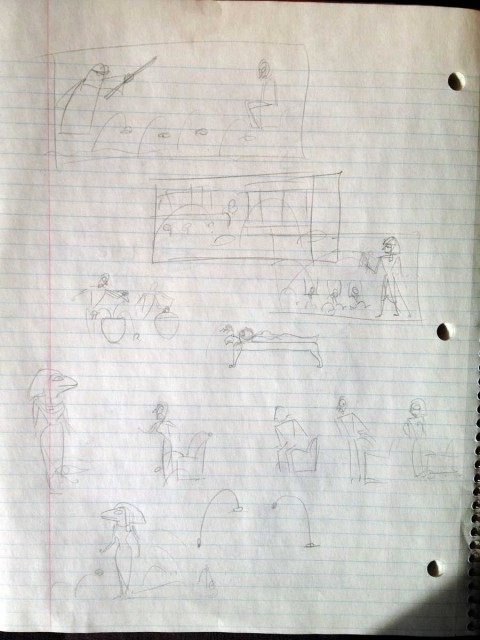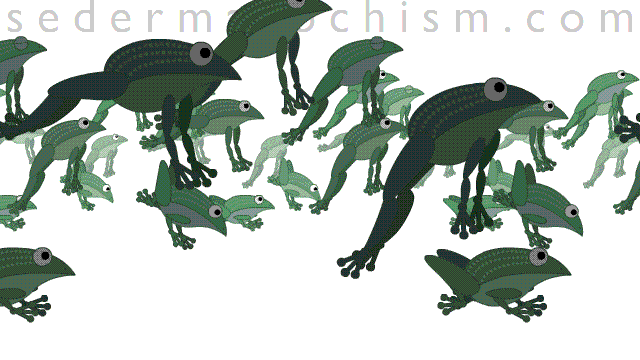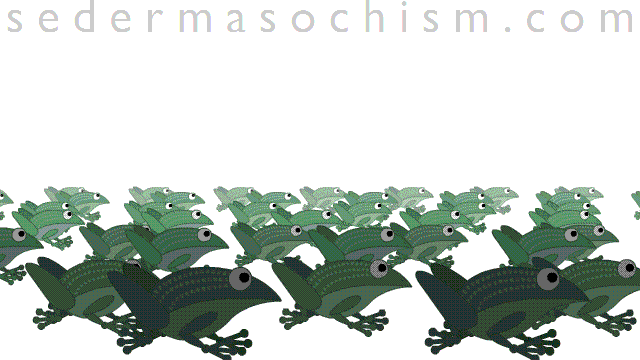Category: work-in-progress
The First Plague (Blood) – rough
“17 Thus saith the Lord, In this thou shalt know that I am the Lord: behold, I will smite with the rod that is in mine hand upon the waters which are in the river, and they shall be turned to blood.
“18 And the fish that is in the river shall die, and the river shall stink; and the Egyptians shall lothe to drink of the water of the river.
“19 And the Lord spake unto Moses, Say unto Aaron, Take thy rod, and stretch out thine hand upon the waters of Egypt, upon their streams, upon their rivers, and upon their ponds, and upon all their pools of water, that they may become blood; and that there may be blood throughout all the land of Egypt, both in vessels of wood, and in vessels of stone.” — Exodus 7, King James Version
Like many storytellers, I use Moses alone to represent both Moses and Aharon. When I deviate from the texts, it’s on purpose.
Music: “Blood Red River Blues” by Josh White (1933), severely edited by me. With great effort I bought a CD with this song, but the quality was terrible – it sounded like a tape player under a mattress – so I ended up copying audio from this YouTube video.
The second stanza depicts Anuket, goddess of the Nile. I hope there are no Ancient Egyptian Religious fundamentalists out there, because they might not like the implication She’s menstruating. Then again, the whole Book of Exodus is anti-Ancient-Egypt propaganda. If there were an Ancient-Egyptian-Anti-Defamation League, Exodus would be banned.
The Third Plague (Lice) – rough
The Third Plague (Lice) – rough from Nina Paley on Vimeo.
“16 And the Lord said unto Moses, Say unto Aaron, Stretch out thy rod, and smite the dust of the land, that it may become lice throughout all the land of Egypt.
“17 And they did so; for Aaron stretched out his hand with his rod, and smote the dust of the earth, and it became lice in man, and in beast; all the dust of the land became lice throughout all the land of Egypt.”
–Exodus 8, King James Version
Like many filmmakers, I use Moses to represent both Moses and Aharon.
The music is “Insects” by Oingo Boingo (1982). The lyrics, which are hard to understand here (but will get a bit easier when we get to flies and locusts) are:
Tiny insects in my hair
Tiny insects everywhere
Tiny insects in my pants
Watching insects make romance
Insects make you make me want to dance
Dance (dance)
They make me want to dance
Dance (dance)
Those insects make me want to dance!
Frogz
Having found suitable song snippets for all Ten Plagues, I am now animating them. This frog is adapted from one in Sita Sings the Blues, where it appeared in “Am I Blue.” In Seder-Masochism it stars in the Second Plague, “Frogs.” Above, a nice messy mass o’ frogs (on a beat of 13.5 frames – the song itself is 13.3 frames per beat, but close enough). Below: same frogs marching in a 27-frame lock-hop.
The Ninth Plague – ROUGH
This is a ROUGH. It will probably change before the final film. I’m just happy I found the perfect song for the Ninth Plague (Darkness): “Who Turned The Light Out In My Life” by Daniel Boone, from the early 1970’s. There aren’t a lot of songs about lice, flies, and locusts (other than Death Metal, which I can’t use because the words are indecipherable) but I managed to find one, plus songs for murrain, boils, and the rest. All will be used well out of their original context.
Moses is shown way bigger than Pharaoh here because he’s about to win. In an earlier scene (which I’m working on right now) Moses is much smaller than Pharaoh, a la planar Egyptian wall art which scales characters according to their power.
From Exodus 10:
21 And the Lord said unto Moses, Stretch out thine hand toward heaven, that there may be darkness over the land of Egypt, even darkness which may be felt.
22 And Moses stretched forth his hand toward heaven; and there was a thick darkness in all the land of Egypt three days:
23 They saw not one another, neither rose any from his place for three days: but all the children of Israel had light in their dwellings.
24 And Pharaoh called unto Moses, and said, Go ye, serve the Lord; only let your flocks and your herds be stayed: let your little ones also go with you.
25 And Moses said, Thou must give us also sacrifices and burnt offerings, that we may sacrifice unto the Lord our God.
26 Our cattle also shall go with us; there shall not an hoof be left behind; for thereof must we take to serve the Lord our God; and we know not with what we must serve the Lord, until we come thither.
27 But the Lord hardened Pharaoh’s heart, and he would not let them go.
28 And Pharaoh said unto him, Get thee from me, take heed to thyself, see my face no more; for in that day thou seest my face thou shalt die.
29 And Moses said, Thou hast spoken well, I will see thy face again no more.
QUANTITATIVE STRETCHING by Theodore Gray
Crossposted from Theo’s new stitchblog. We’re rearranging palegraylabs.com and will hopefully have a functioning blog there soon. –Nina
Welcome to my new Stitching Blog. It’s like my regular blog except all about quilting and embroidery. I’ve separated the two, because I get the feeling that people interesting in my science writing and app-making activities may find all the stitching a bit tedious, and vise-versa. Also, I have taken the liberty of using the same list of subscribers to my stitchcam as the list to be notified (via rss feed) when there’s a new post on this blog. I figure if you’re interested enough in stitching to get real-time notifications of a quilting machine running, you’re probably interested enough to hear about an occasional blog post.
So without further ado, my first new stitching-related blog post. I’m afraid it’s a rather technical one….
One of the big problems with fabrics and quilting is that fabric is not a proper engineering material. It’s stretchy and sloppy and never goes exactly where you want it to. The situation only gets worse when you add batting to the equation.
We’ve been experimenting with extra-thick batting, as much as two inches thick, and have had a problem with the resulting “quilts” not lying flat, because some parts of the pattern shrink the dimensions of the fabric more than other parts, resulting in a sheet that is internally stressed.
You might think it’s a simple case of more stitches equals more shrinkage (as it more or less is with embroidery), but this is not the case.
To see why, consider a cross section of a quilt with different spacings between the quilting lines. When there are no lines, the fabric on the top and bottom are flat, and the piece overall will be just as long as the fabric originally was. As you add more lines, the fabric is forced to go up and down, so even if the fabric isn’t physically compressed, the piece overall will get shorter.
Here is a schematic illustrating this fairly obvious fact. Clearly if the lines (the top and bottom fabric) stay the same length, the overall length of the quilt must get shorter.

But what if you keep going? There is a fallacy in this drawing: The thickness of the quilt is staying the same. Clearly the following is NOT what happens if you add even more lines:

These diagrams get more and more absurd, because of course what actually happens is that the batting gets hammered down, the piece gets thinner overall, and the fabric goes back to being flatter. And that means the overall piece should start getting LONGER again, at a certain point. That’s what I wanted to confirm and quantity, so I had Behemoth stitch twelve different test strips like these, each about a meter long:

Here is the diagram again, except this time the widths shown are real, measured widths from my experiment. (In the diagram below, the number of humps is real and the relative lengths are real, but the thicknesses are schematic, because I didn’t measure the actual thicknesses):

As you can see, there is a minimum length around 30 humps, and by the time you get to 200 humps (0.5cm line spacing) the thing is well on its way back to its original length.
Here is a plot of the lengths as a function of line spacing (the right-most data point represents infinite line spacing, in other words the original fabric length):

The interesting fact about this is that, because there’s a minimum, there are going to be two ways to get any given amount of shrinkage, a large-spacing way and a small-spacing way, one on either side of the valley. In order to get a quilt that lays flat, you don’t have to keep all the spacings the same, you can have zones of stitching width spacings on either side of the minimum.
These tests were all with lines in only one direction, but what if you add crossed lines in the other direction? I did a second set of twelve test strips with lines going in both directions, like these:

The following graph is a bit harder to read. The horizontal axis represents the line spacing in the direction of shrinkage (just like in the graph above). The vertical scale is again overall length of the piece. The lines connecting data points represent sets of similar spacing in the lines going the other direction. The bottom set has no cross-lines (i.e. it’s the same data points as the graph above, except a smaller number of them shown). As you go up, each line represents more and more closely spaced cross-lines. The data points are labeled with the line spacing in the shrinkage and crossed directions respectively.

The result is as expected: The more closely spaced the crossed lines are, the less shrinkage there is, regardless of how closely spaced the lines are in the shrinkage direction.
Now all we need to do is actually use this information to make something pretty that doesn’t warp…. In the mean time, we’ve been experimenting with the other solution: Stretching on a frame.

This quilt is “double-quilted”, using the term Nina invented for a thing I decided to try because why not. It’s basically a quilt on top of a quilt, so we can have a secondary level of relief that isn’t hammer down overall. I’ll write a full blog post about this technique later, but here’s a closeup that gives an idea of what it looks like:

Was all the quantitative measuring useful? Maybe…. So far I’ve used it only to create an interpolating function that I have used in some calculations involving how wide to make flaps that wrap around the wooden frame holding up stretched quilts like this. Hm, that’s probably another blog post too.



